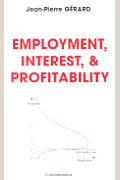Studies in this week’s Hutchins Roundup find that corporate cash holdings are linked to employment, SNAP benefits have larger-than-expected effects on food consumption, and more.
Want to receive the Hutchins Roundup as an email? Sign up here to get it in your inbox every Thursday.
Firms’ liquidity requirements can explain why cash holdings tend to be high when employment is low
In the aftermath of the U.S. financial crisis, employment fell and corporate cash holdings rose. Philippe Bachetta and Kenza Benhima of the University of Lausanne and Céline Poilly of Aix-Marseille University find that this relationship is not specific to the recent financial crisis. From 1980 to 2015, the corporate cash ratio—the ratio of corporate liquidity to total assetswas high when employment was low, and firms with a higher cash ratio tended to have lower employment. The authors show that firms’ liquidity requirements can link the two phenomena. In their model, firms need cash to pay their employees, so must either hold cash or have access to external liquidity sources, like credit lines or trade credits, which provide cash at short notice. If external liquidity becomes scarcer, as it did after the collapse of Lehman Brothers in 2008, firms become more reliant on cash to meet their salary obligations and increase their cash holdings. Lower external liquidity also reduces the financial opportunities of firms, making it more difficult to finance production and leading them to reduce employment.
SNAP benefits have larger-than-expected effects on food consumption
The Supplemental Nutrition Assistance Program (SNAP) provides households with loaded debit cards that can be spent on groceries, but the benefit may also increase non-food consumption by adding to households’ total income. Using transaction and administrative data, Justine Hastings and Jesse Shapiro of Brown University show that a $1 increase in SNAP benefits leads recipients to increase spending on SNAP-eligible food by about 50 cents, a much larger increase in food spending than would be expected from a $1 increase in cash income. Even households whose monthly food expenditures exceed the SNAP benefit—for whom an increase in the SNAP benefits is economically equivalent to cash—sharply increase food spending in response to an increase in the SNAP benefit. The authors speculate that households treat SNAP benefits as part of a separate mental account, suggesting that excluding certain items from the benefit—like sweetened soda—could affect households’ food choices.
The financial crisis led to lower small business lending for a decade
During the financial crisis, banks that were exposed to the collapse of the housing sector systematically pulled back from lending to small firms. However, banks that were relatively less exposed actually expanded their small business lending, and partially offset the aggregate decline in credit. Still, Vitaly Bord and Victoria Ivashina of Harvard University and Ryan Taliaferro of Acadian Asset Management show that the net contraction in credit persisted for a decade after the crisis, and led to lower small business formation and employment until 2015. In addition, counties with banks that were relatively more exposed to housing were hit the hardest: The authors find these counties saw the number of small firms decline by 1.5 percentage points more in the decade after the crisis than did counties where banks were healthier.
Chart of the week: Wage growth has picked up for workers in the bottom half of the income distribution
Quote of the week
“Financial history rhymes all too frequently, with enormous costs to our citizens. We must remain vigilant, resist the three lies of finance, and reinforce some core financial truths. The first lie of finance is the four most expensive words in the English language: ‘This Time Is Different.’ It took a revolution in macroeconomic policy to help win the battles against the high and unstable inflation, rising unemployment and volatile growth of the 1970s and 1980s. But these innovations did not deliver lasting macroeconomic stability. Far from it. Price stability was no guarantee of financial stability. An initially healthy focus would become a dangerous distraction. Against the serene backdrop of the so-called Great Moderation, a storm was brewing as total non-financial debt in the G7 rose by the size of its GDP,” says Mark Carney, governor of the Bank of England.
“The second lie, the belief that ‘markets always clear,’ has two dangerous consequences. First, if markets always clear, they can be assumed to be in equilibrium— or said differently ‘to be always right.’ If markets are efficient, then bubbles can neither be identified nor can their potential causes be addressed. Such thinking dominated the practical indifference to the housing and credit booms before the crisis. Second, if markets always clear, they should possess a natural stability. Evidence to the contrary must be the product of either market distortions or incomplete markets. […] A truth of finance is that the riskiness of an asset depends on who owns it. When markets don’t clear, agents may be surprised to find what they own and for how long. When those surprises are – or are thought to be – widespread, panic ensues.”











Commentary
Hutchins Roundup: Corporate cash, SNAP benefits, and more
October 25, 2018